The Irish labored to put away Duke in the season opener, struggling to find a consistent offensive rhythm and letting up some uncharacteristic explosive plays on defense early. It was reminiscent of last season’s unsatisfying opener, with similar advanced stats – a decent win that felt closer than it needed to be and raising questions about what this team will become.
Explosiveness
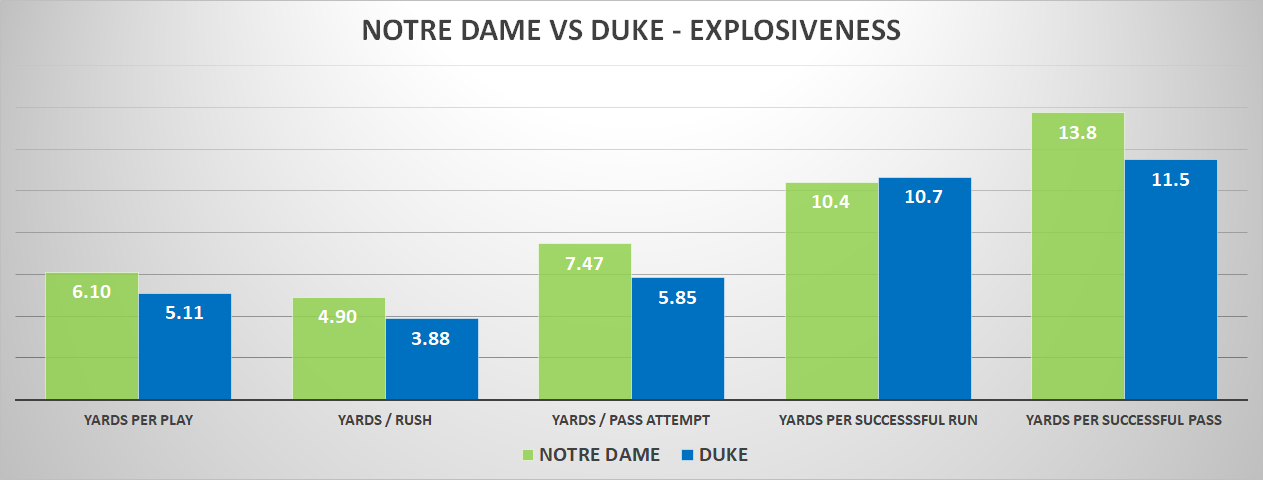
Notre Dame’s advantage of close to one yard per play was very similar to last year’s opening game at Louisville (+1.2). The offense struggled mightily to begin the game, with 0.7 yards per play and a 0% success rate (shut out!) in the first quarter of the Tommy Rees era as permanent OC. Kyren Williams was able to eventually jumpstart the offense, and a classic bend but don’t break Clark Lea performance cemented the win, but winning is hard and this one felt like ND had to earn every advantage.
It felt like an uneven performance by Ian Book, but then you check the numbers, and the passing game posted 7.5 yards per attempt and solid efficiency (43% success rate, national average around 40%). The stats may be a little deceiving – the most explosive play by far came on a 75-yard screen to Kyren Williams that didn’t travel any yards downfield. One of the biggest questions of the season was what a Tommy Rees offense would look like, and there was far from a complete answer on Saturday. A solid Duke defense and the absence of Kevin Austin and Braden Lenzy didn’t help, but the offense felt very conventional and somewhat conservative at times, running the ball on 57% of early downs.
Williams, Tyree, and the tight ends stretched the field horizontally, but there were few vertical threats minus a missed deep shot to Lawrence Keys and a few back-shoulder connections. Ben Skowronek suffering an apparent hamstring injury fills the receiver room with unproven faces, but Joe Wilkins filled in admirably with four successful plays in five targets. Still, receivers had just 12 of 31 pass targets, with 11 going to the tight ends and eight to running backs.
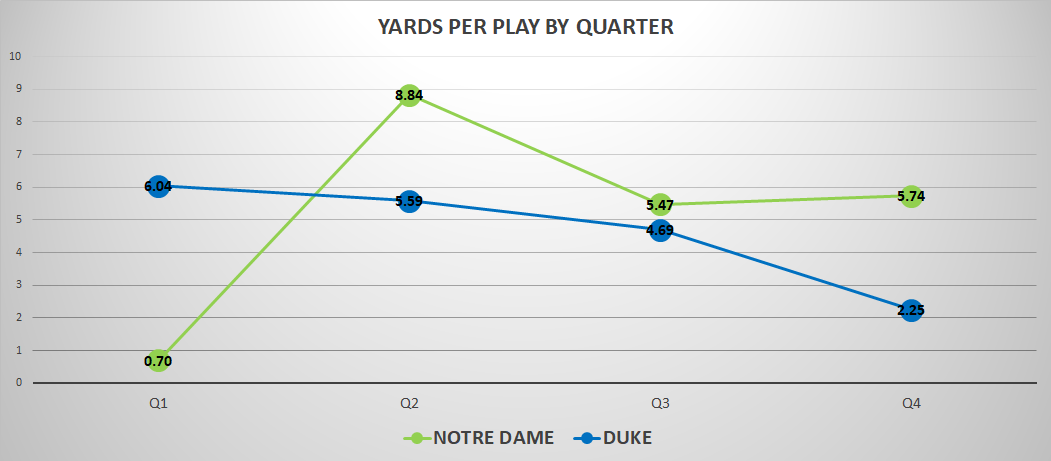
Continuing the theme of being very similar to last year’s Louisville game, the Irish gave up 5.3 yards per play in that game and 5.1 in this contest. As with the first game of the Scott Satterfield era, it’s hard to know the quality of this Duke offense with Chase Brice now at QB. But allowing less than four yards per carry and six yards per pass attempt is a winning formula, especially given some uncharacteristic tackling problems early and the loss of Kyle Hamilton in the second half. The Irish allowed just one pass of 50 yards last season and equaled that total in the first half with yards after the catch given up on a 55-yard gain.
Generally, though, this was still the Lea defense we know and love. There were just two explosive runs (12+ yards) in the game, one a late Brice scramble when the defense prioritized preventing a big play downfield. Cutcliffe wisely schemed to get Brice outside the pocket to avoid the ND pass rush, but they were still highly disruptive with three sacks and a number of hurries and forced incompletions.
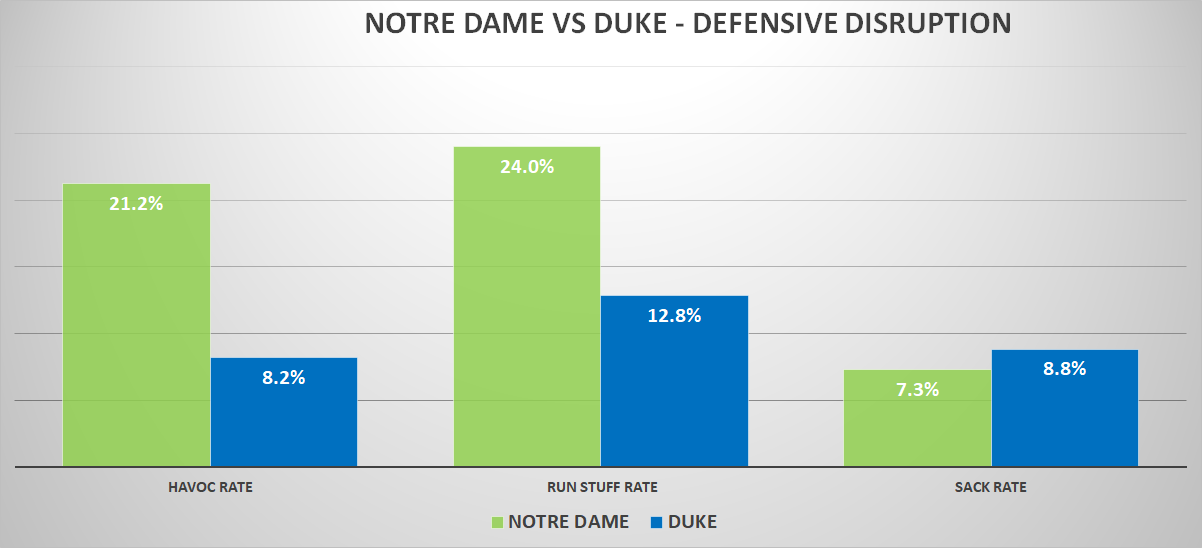
We knew Jeremiah Owusu-Koramoah was going to be a monster, and he built on his Camping World Bowl success with 2 TFL, a sack, and a forced fumble. Isaiah Foskey looked like a monster off the edge, and the defensive backs were a little unlucky to come up without an interception off of six pass break-ups. Meanwhile, the Duke defense held things in check without being too disruptive, posting three sacks but very few run stuffs and zero pass break-ups (not including the one pick).
Efficiency
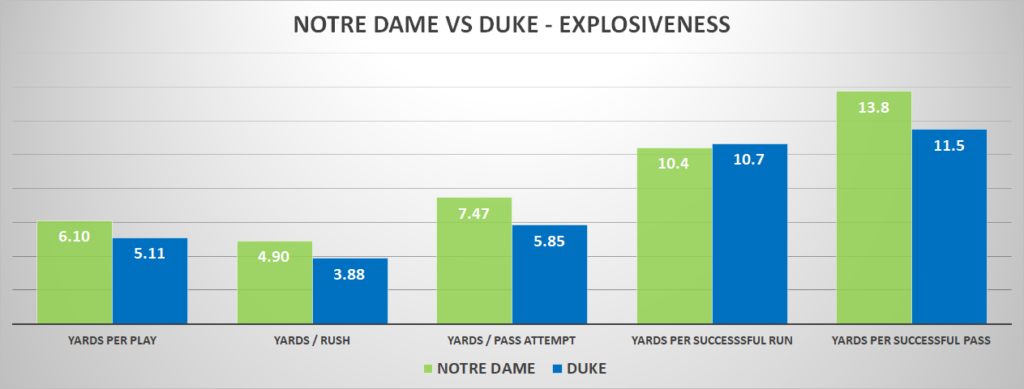
Brice and Cutcliffe took some shots at the Notre Dame secondary, but come up with a paltry 5.85 yards per attempt that steadily declined throughout the contest. While Clark Lea has shown the ability to mix up the shape and scope of his defense from year to year with personnel and often matchup to matchup, this roster construction would seem to lead to more of the same bend but don’t break. It’s a confident bet that opponents can’t string together long drives while the Irish defense has plenty of chances to create negative plays, turnovers, or force passing downs where the pass rush and safeties can shine.
Questions will remain in the secondary, but Nick McCloud and Tariq Bracy acquitted themselves well against a nondescript receiver group. The severity of Kyle Hamilton’s injury will loom as the big question, but the favorable early ND schedule – looking even nicer, considering Florida State’s opening game – means his presence shouldn’t be necessary until Louisville.
For the offense, the Blue Devils made the Irish offense earn every bit of their average success rate. This Duke unit projected 35th in Defensive SP+ and may have one of the best DE pairings Notre Dame will face, but other teams will likely try to replicate their rough formula in the near-term. Load up with lots of bodies near the line of scrimmage, contain the run, and try to make Book uncomfortable in the pocket, and forcing young wide receivers to make you pay over the top. With Austin and Lenzy in the fold, it’s easy to feel good about those odds, but it’s a different story when those threats are limited to Keys, Wilkins, and McKinley.
Going back through the game, there are reasons for optimism and skepticism for the offense in Book Year 3. Two key areas of easy improvement I focused on in the offseason were run stuff rates and power success rate. Run stuffs (zero or negative yards gained), especially on early downs, are an efficiency killer and it’s mind-boggling the Notre Dame run game has been well below average in this category the past two seasons. The national average is around 20%, and Saturday’s rate of just over 12% would be a top-5 mark nationally. Chris Tyree accounted for four of Notre Dame’s five stuffs with only six carries – yikes! But Kyren Williams had just one stuff in 19 carries.
Notre Dame was also 4 of 5 in power success situations – running the ball on 3rd or 4th and two yards to less to gain. In 2019 the Irish only converted 62.9% of these runs, which was 109th nationally. If the offensive line can make some traction in those easy areas, it will go a long way to making life on the ground easier.
But every point felt hard-earned – a quick selection of the components of Notre Dame’s scoring drives:
- Touchdown 1: fake-punt from your own 20 to inject life into the offense, a gift face mask moves the Irish from the Duke 48 to 22 in one play
- Field Goal 1: a very untidy 2-minute drill, with a Book interception negated by an offsides penalty he hopefully knew about. Some weird clock management and nice Wilkins catches to set up a long Doerer field goal he converts from 48 yards out.
- Touchdown 2: the offense receives great field position after the defense forces a Duke fumble, and a 4th and 1 conversion goes 26 yards for a touchdown
- Touchdown 3: Michael Mayer creates something out of nothing for a first down on 3rd and 7, and Avery Davis comes down with a 50/50 ball in the end zone
- Field Goal 2: very legitimate, but again off a short field after a poor Blue Devil punt, with the drive stalling with two Tyree runs for -4 yards total from the Duke 17
This may feel nit-picky, and some of these are well-earned edges you get from being a more talented team. But the Irish moving forward will need to find more easy points, like those that should have been earned off the 75-yard screen to Williams but were fruitless after an errant Book throw on the ensuing play.
Finishing Drives, Field Position, & Turnovers
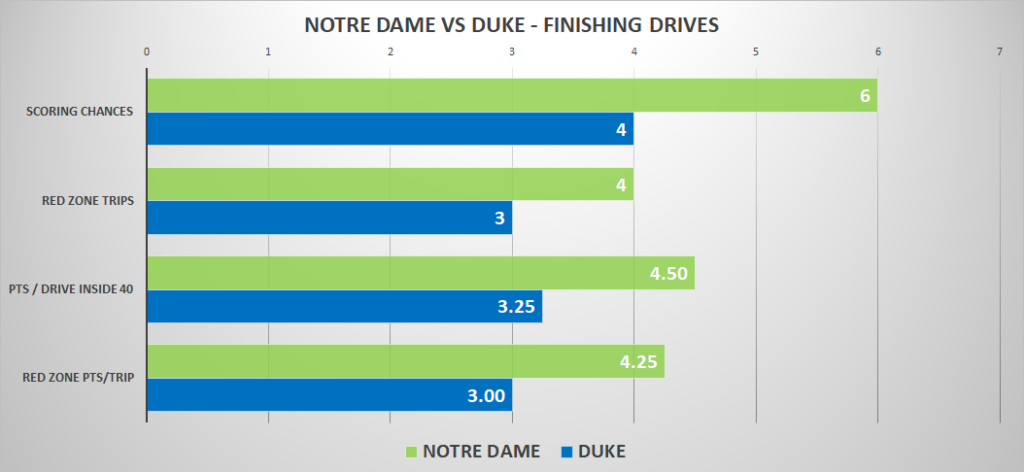
There were red zone and scoring opportunity (defined as a 1st down inside the opponent 40) issues for both teams, but Notre Dame fared a bit better and unsurprisingly created more scoring opportunities. The Book interception was the killer for Notre Dame, and the field goals more acceptable than most since one came with the first half ending and the second late in a game that was well in hand.
The Blue Devils had only two successful plays in ten red zone attempts, as the Irish mostly shut things down in key areas of the field. Duke’s inability to get anything going on the ground hampered them, although Brice was able to take a keeper into the end zone. It’ll be interesting to see the contrast next week going from a pocket passer like Brice to USF’s rotation of running QB’s (that broadly speaking can’t throw).
The field position battle ended in a draw, with just a yard separating each team’s average starting spot (ND their own 25, Duke their 26 yard-line.). All three turnovers came in opponent territory, and the specialists for both teams were solid with a mishit or two shuffled into the punting.

Turnover luck was fairly even in this one, with Duke a bit unlucky to lose both of their fumbles but happy to not give away any interceptions despite six Irish PBU’s. “Expected turnovers” are calculated based on historical data that shows a team should expect to recover half of the available opponent fumbles, and that roughly one in five (22%) of pass break-ups result in an interception. It’s worth noting that despite Book’s shakiness the Duke defense only was credited with one pass break-up in the form of the end zone interception off Tremble’s hands.
What next?
The first games of a season are difficult because we always want to ascribe a narrative to what we’ve seen, but it may or may not play out. Brandon Wimbush went from clutch performer doing the gritty stuff to beat Michigan to benched in the course of a September. A year ago the primary concern defensively was the linebackers, laughably in hindsight.
We will learn a lot more through the next few games before the massive three-game stretch of FSU (looking less massive!), Louisville (scary), and Pitt. What does this offense look with the threat of Braden Lenzy? Can the run game build on the second half success? Does someone end up winning the Buck linebacker spot? Does Book settle in and show the desired improvement? We just don’t know, but the next two weeks will give us a better clue about the Irish and their opponents.

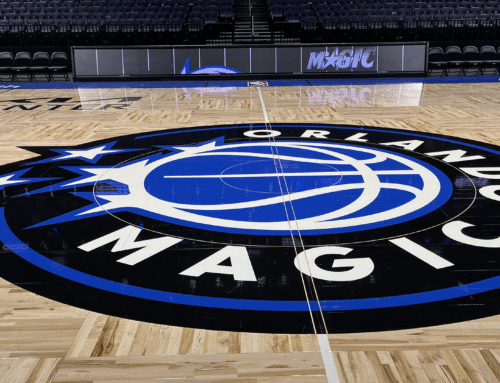
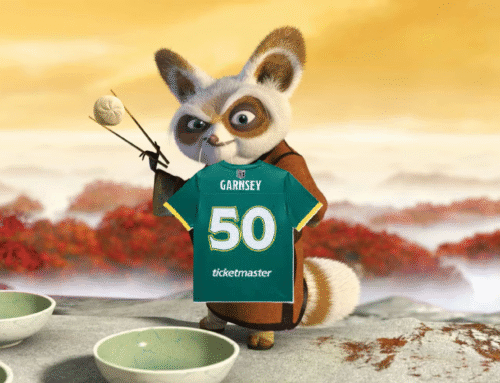
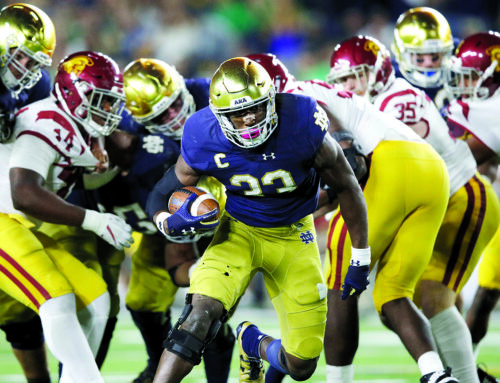
Really love the Yards Per Play by Quarter chart, especially since it helped to put some numbers to what I seemed to see during the game. Early on, guys on both sides of the ball looked way too amped up. Book was jittery in the pocket. Williams wasn’t reading blocks and looked like an RB in his first career start. Even the LBs and Wu were playing way too fast and overruning every play.
But that’s the nice thing about having quality returning veterans at so many positions. ND teams from 5+ years ago may have let that first quarter start to spiral into disaster. Instead, the defense kept us right where we needed to be, never letting us get down by more than a field goal, keeping the offense from having to scramble to get back into the game.
While we may not be at the elite level of a Clemson/Bama/OSU, it’s really nice to no longer fear that we’re going to drop down to a team outside of the Top 25. It’s quite nice to watch your team play a terrible quarter of football, against a P5 opponent, and not have to fear that the roof is caving in.
Really hoping for a crisp 3-step drop and slant to Lenzy early against USF.
Boy, how nice is it to be able to add the “un” to “characteristic”